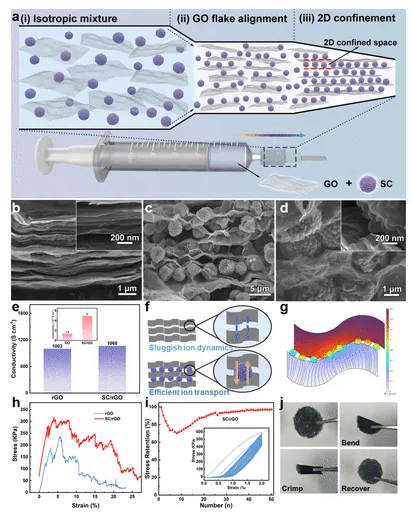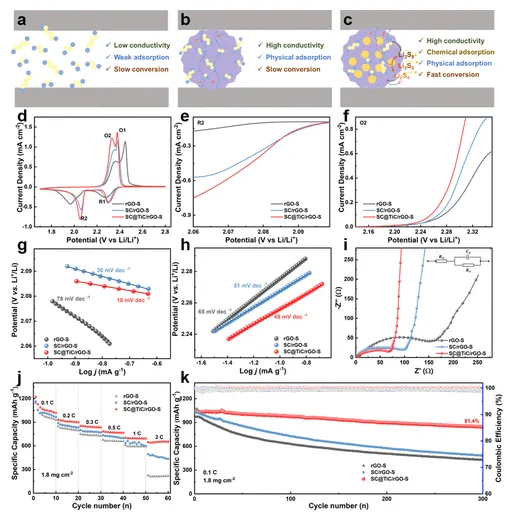Zhejiang University in ACS Nano: Roller-like Spore Carbon Sphere-Directed Graphene Fibers for Lithium-Sulfur Batteries
1. Summary

Researchers from Zhejiang University and Zhejiang Sci-Tech University have developed self-supporting graphene fibers embedded with roller-like spore carbon spheres through rheological engineering. These fibers serve as electrodes for flexible lithium-sulfur batteries, offering superior electrochemical properties along with enhanced mechanical strength and structural stability. This advancement shows promise for use in wearable electronics and energy storage systems.
Key technologies include:
- Microfluidic co-spinning: Spore carbon spheres self-assemble within graphene fibers to form rolling structures.
- Plasma reduction: Improves conductivity and catalytic activity of the fibers.
2. Key Design and Characterization
Structural and Functional Advantages:
- Roller-like spore carbon spheres (SC) interact with graphene sheets to enhance electrical contact within the electrode.
- Improved shear viscosity and rheological behavior: Enable the composite fibers to exhibit better electrical conductivity and mechanical stability.
Electrochemical Performance Highlights:
- High specific capacity: >1000 mAh/g
- Extended cycle life: Suppresses lithium dendrite growth and mitigates polysulfide shuttle effects.
3. Visual Analysis

Figure 1: Structure and Characterization of SC/rGO
- (a) Schematic of SC/GO synthesis.
- (e, f) Electrical conductivity and ion transport behavior of rGO and SC/rGO.
- (g) COMSOL simulations of the potential distribution in SC/GO electrodes.

Figure 2: Polysulfide Adsorption and Catalysis
- (a-f) Synthesis and characterization of SC@TiC composites.
- (d) CV curves showing polysulfide reduction peaks and catalytic activity.
Figure 3: Mechanism of Polysulfide Conversion

- (a-c) Adsorption of polysulfides on TiC and carbon surfaces.
- (f, g) Catalytic effects of TiC during Li₂S precipitation.
4. Electrochemical Performance and Simulations
- Polysulfide shuttle suppression: Spore carbon spheres and TiC composites improve the capture and conversion of intermediates.
- Lithium dendrite suppression: Uniform nucleation sites prevent dendrite formation on the anode side.
- Flexible battery performance: SC@TiC/rGO electrodes maintain mechanical stability under tensile cycling.
5. Conclusion
The study introduces self-supporting graphene composite fibers with roller-like structures, highlighting the following key innovations:
- Enhanced electrochemical activity: Physical and chemical synergies facilitate polysulfide capture and catalytic conversion.
- Exceptional mechanical stability: The flexible graphene fibers withstand deformation and stretching.
- Dendrite suppression: Uniform nucleation points improve lithium metal anode stability and cycling performance.
This research provides a promising new method for the development of high-performance lithium-sulfur batteries and lays the foundation for advanced energy storage solutions for flexible electronics.
Reference
Zhou, J., Xia, X., Shen, S., et al. Roller-like Spore Carbon Sphere-Orientated Graphene Fibers Prepared via Rheological Engineering for Lithium-Sulfur Batteries. ACS Nano (2024).
https://doi.org/10.1021/acsnano.4c07864

